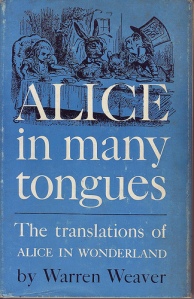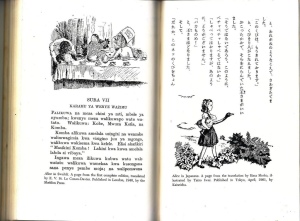 Alice's Adventures in Wonderland by Lewis Carroll.
Alice's Adventures in Wonderland by Lewis Carroll.Illustrated by Tove Jansson.
ISBN: 0440000750 or 0440000696
Published by Delacorte Press. My copy- second printing, 1978. The illustrations in colour and in black and white are copyright 1966, same as me ;)
Hardback with dustjacket.
Tove Jansson is, of course, best known for the Moomins, who are currently undergoing something of a revival. I suspect that's partly why this book comes up quite expensive.
Jansson was born and died in Helsinki: 1914 and 2001. I'll let you decide which date is which. She's also illustrated the Snark, but I've yet to find that one.
You can see all the illustrations here. I love the use of the Lewis Chessmen as models for the King and Queen of Hearts.
Bought from Oxfam via Amazon for £40 or so. Still some copies on there: Alice's Adventures in Wonderland

 Alice in Many Tongues: The Translations of Alice in Wonderland by Warren Weaver.
Alice in Many Tongues: The Translations of Alice in Wonderland by Warren Weaver.Published by the University of Wisconsin Press, 1964.
Hardback first edition with dust jacket.
Warren Weaver was a civil engineer and mathematician who studied at the University of Wisconsin. He was a pioneer of machine translation.
There is a history of translations of Alice's Adventures in Wonderland, and a bibliography at the back of all the foreign editions that Weaver was able to locate.
My favorite part is the chapter "How can Alice be Translated" which looks at the 'quality' of the a few versions by examining the way the nonsense, puns and logical jokes in the Mad Hatter's Tea-Party are handled. I've always wondered how translations 'work', so that bit is really fascinating. Some translations handle things rather better than others...
There are some pictures of some of the versions: including Hebrew, Swedish, Swahili, Bengali and Thai.
Bought in the bookshop on Curzon Street with the Nancy Mitford blue plaque.

There's a reprint available on amazon: Alice in Many Tongues: The Translations of Alice in Wonderland
 The Guinness Alice by Ronald Barton and Robert Bevan.
The Guinness Alice by Ronald Barton and Robert Bevan.Pamphlet published by Guinness in 1933, and printed in Great Britain by John Waddington Ltd.
Illustrated by John Gilroy
I have the second edition with full colour illustrations: the first edition had both colour and line drawings.
This series of pamphlets are called "Doctor's Books" as they were sent to GPs' surgeries to encourage the drinking of Guinness for medical purposes: very good for nursing mothers for example!
Guinness began this in 1933, carried on until World War 2 halted the practice, and it only started again in 1950. The booklets were then produced each year until 1966. They were produced by the advertising agency SH Benson, who made many of the iconic Guinness ads. This was the first of the 24 booklets, and the first of five based on Alice. I have all of them, so they'll all make it onto here eventually...
This is graphically the simplest of the Guiness Alices, with spoof versions of several poems and scenes from the books.
Here's Old Father William:
"You are old Father WIliiam", the Young Man said,
"And yet you're remarkably fit,
You sleep from the moment you get into bed,
Which is rare at your age, you'll admit."
"In my youth," said the Sage, "I heard many reports
That Guiness brought rest to the brain,
Since when, if depressed or a bit out of sorts,
I've drunk it again and again."
I might get round to scanning in some of the pages once I'm a bit more caught up with myself...
Available on amazon: The Guinness Alice
(I got mine cheap on ebay...)
 Mr. Tompkins in Wonderland by George Gamov.
Mr. Tompkins in Wonderland by George Gamov.
Published by Cambridge University Press.
This copy 1950: but first published 1940.
8vo hardback with dustjacket.
Illustrations by John Hookham.
The physicist George Gamow uses the adventures of Mr. Tompkins to explain modern scientific theories to a popular audience.
The book is structured as a series of dreams in which Mr Tompkins enters alternate worlds where the physical constants have radically different values from those they have in the real world. This results in the counterintuitive results of the theory of relativity and quantum mechanics becoming obvious in everyday life.
Mr Tompkins' adventures begin when he chooses to spend the afternoon of a day's holiday attending a lecture on the theory of relativity. The lecture proves less comprehensible than he had hoped and he drifts off to sleep and enters a dream world in which the speed of light is a mere 30 miles an hour. This becomes apparent to him through the fact that passing cyclists are subject to a noticeable Lorentz-Fitzgerald contraction:
The hands of the big clock on the tower down the street were pointing almost to noon and the streets were nearly empty.
A single cyclist was coming slowly down the street and, as he approached, Mr Tompkins' eyes opened wide with astonishment. For the bicycle and the young man on it were unbelievable flattened in the direction of the motion…
The clock on the tower struck twelve, and the cyclist, evidently in a hurry, stepped harder on the pedals.
Mr Tompkins did not notice that he gained much in speed, but, as the result of his effort, he flattened still more and went down the street looking exactly like a picture cut out of cardboard.
Then, Mr Tompkins felt very proud because he could understand what was happening to the cyclist-- it was simply the contraction of moving bodies about which he had just learned.
"Evidently nature's speed limit is lower here," he concluded, "that is why the bobby on the corner looks so lazy, he need not watch for speeders."
G. Gamow says:
In the winter of 1938 I wrote a short, scientifically fantastic story (not a science fiction story) in which I tried to explain to the layman the basic ideas of the theory of curvature of space and the expanding universe. I decided to do this by exaggerating the actually existing relativistic phenomena to such an extent that they could easily be observed by the hero of the story, C. G. H. Tompkins, a bank clerk interested in modern science.
I sent the manuscript to Harpers Magazine and, like all beginning authors, got it back with a rejection slip. The other half-a-dozen magazines which I tried followed suit. So I put the manuscript in a drawer of my desk and forgot about it.
During the summer of the same year, I attended the International Conference of Theoretical Physics, organized by the League of Nations in Warsaw. 1 was chatting over a glass of excellent Polish mind with my old friend Sir Charles Darwin, the grandson of Charles (The Origin of Species) Darwin, and the conversation turned to the popularization of science. I told Darwin about the bad luck I had had along this line, and he said: ‘Look, Gamow, when you get back to the United States dig up your manuscript and send it to Dr C. P. Snow, who is the editor of a popular scientific magazine Discovery published by the Cambridge University Press.’
So I did just this, and a week later came a telegram from Snow saying: ‘Your article will be published in the next issue. Please send more.’ Thus a number of stories on Mr Tompkins, which popularized the theory of relativity and the quantum theory, appeared in subsequent issues of Discovery. Soon thereafter I received a letter from the Cambridge University Press, suggesting that these articles, with a few additional stories to increase the number of pages, should be published in book form. The book, called Mr Tompkins in Wonderland, was published by Cambridge University Press in 1940 and since that time has been reprinted sixteen times. This book was followed by the sequel, Mr Tompkins Explores the Atom, published in 1944 and by now reprinted nine times. In addition, both books have been translated into practically all European languages and also into Chinese and Hindi.
Chapter headings:
1. City Speed Limit
2. The Professor’s Lecture on Relativity which caused Mr Tompkins’s dream
3. Mr Tompkins takes a holiday
4. The Professor’s Lecture on Curved Space Gravity and the Universe
5. The Pulsating Universe
6. Cosmic Opera
7. Quantum Billiards
8. Quantum Jungles
9. Maxwell’s Demon
10. The Gay Tribe of Electrons
10.5. A Part of the Previous Lecture which Mr Tompkins slept through
12. Inside the Nucleus
13. The Woodcarver
14. Holes in Nothing
15. Mr Tompkins Tastes a Japanese Meal
Bought in Marchpane for £30, available as a modern reprint on amazon: Mr. Tompkins
No comments:
Post a Comment